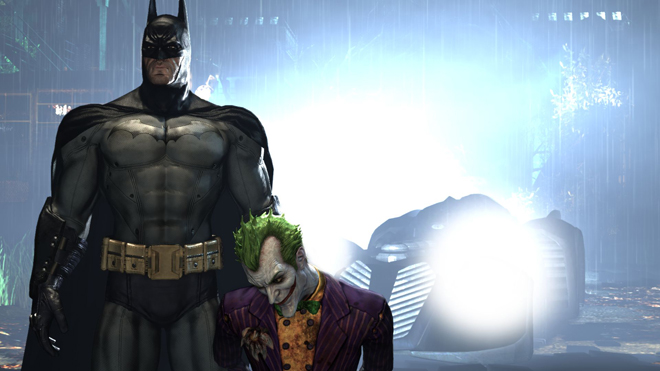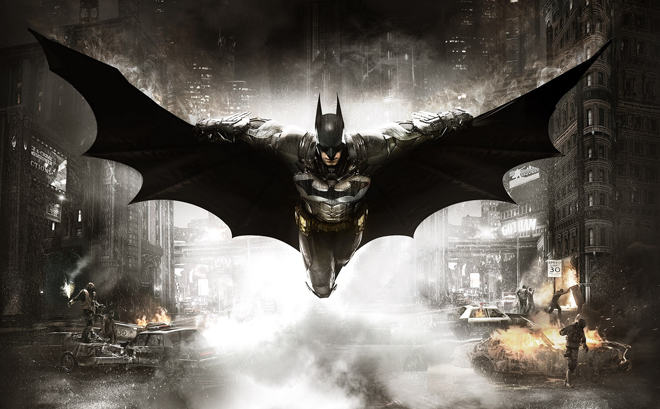Batman: Arkham Knight — Attack of the Drones

Batman: Arkham Knight both ponders and answers one question: What does a sequel need to present to be an essential upgrade to its predecessors? The dilemma isn’t dissimilar to one other sequels try to answer, particularly if they’re following critically and commercially-successful installments. But Warner Bros. subsidiary Rocksteady Studios had a much larger mountain to climb than others with the Batman: Arkham titles, thanks to the legacy associated with its title character.
Arkham Asylum provided an enjoyable 3D Metroidvania-style adventure with Batman’s journey through, well, Arkham Asylum. This ante was upped through the developers taking an open world approach with Arkham City, to varying results. While having open environments introduced issues, with its city having large sections with nothing to do in them and at times seemingly existing for the sake of having nonlinearity, Rocksteady’s skilled team sought to refine this approach with Arkham Knight. They expanded the number of options available to the player in an open world starring Batman, in order to make the best game in the franchise. It’s an amicable goal that very well should be their itinerary, but while some of Arkham Knight’s gameplay features complement each other, others feel like they exist to check a box on the AAA Video Game Prerequisites list.
(I’m delving a little into the plot in the next paragraph, which I can’t do without mentioning a huge spoiler for the end of Arkham City. If you haven’t finished it, skip past this.)
From the time its concept was planned, there was no chance of Arkham Knight retaining the feel of the previous Arkham games’ worlds. The Joker is seriously killed off at the end of Arkham City, and you’ll spend a good minute at the very beginning of this game charring his dead carcass. This opens the story for another villain to take the lead role, and that happens to be the Scarecrow. Considering how often the Joker is used in Batman media (including the last three games), it’s a refreshing change of pace.
(Spoilers end here; you can read in peace.)

Like the last game, however, Arkham Knight features an assortment of villains from Batman’s Rogues Gallery. Second to Scarecrow is a new villain Rocksteady created for this game, the other title character known as the Arkham Knight. Not much is known about him initially, outside of how he’s familiar with Batman’s playbook to a frightening degree. Other villains are relegated to side missions, though some are often treated with the same importance as characters in the main missions, like Two-Face, the Riddler, and the Penguin.
Just the same, other Gotham heroes join Batman in his quest, primarily returning characters of varying importance. I didn’t mind having Oracle and Alfred share the role of being Batman’s main assistants, and there’s nothing wrong with having more Robin (Tim Drake). But Catwoman gets much less on-screen time here compared to Arkham City. And though it’s nice that they gave Nightwing lines this time around, he’s relegated to extra missions. Rocksteady clearly didn’t have the resources to make everyone relevant in the grand scheme of things, but both characters are more important to Batman’s universe than this game treats them. Still, the story tells an enjoyable tale about the mountain Batman himself needs to climb to save Gotham again. Though there’s plenty of fanservice (of both kinds), it’s one of the better Batman-related stories– the ending aside.
Scarecrow’s influence can be felt throughout its world, set in the wide, sprawling environment of the infamous Gotham City this time around. This gave Rocksteady more freedom, and they mostly did a good job.

To lower the expectations of anyone who thought we’d receive a living and breathing iteration of the city, the game tells everyone up front that it’s been cleared of all inhabitants. They’re all prompt in their departure, as if concurrently realizing “Oh wait, I live in Gotham City.” Gotham is under threat of being bathed in fear toxin, which means the environment is just as disappointingly barren of normal life (outside of similar-looking hooligans wandering about) as Arkham City’s. At least there’s more to do in this game, despite most missions being sidequests.
What really attracted me to Gotham was its beautiful retro-futuristic design (complete with matching clothing styles and police uniforms), heavily inspired Batman: The Animated Series. Gotham in Arkham Knight is around three times bigger than Arkham City, meaning Batman will need a faster method of transportation that you’ve undoubtedly heard of by this time: the Batmobile. It’s possible you’re also well aware of its divisive nature, and it takes only minor fiddling to figure out why.
The vehicle controls great after mastering the controls, as the Batmobile handles more like an arcade racing game car compared to a simulation one. The battles with drones are fun too, utilizing the tank of a Batmobile’s cannon and gun while dodging attacks and shooting incoming missiles, especially as more abilities are unlocked. Rocksteady knew they had a good thing going in adding the Batmobile here, and crafted many sections around its use — too goddamn many. It feels like they were determined to make players sick of it by the time they were 75% of the way through. That’s too bad, because it’s the last 25% where they really up the ante, but you’ll be dying for it to end.

That’s not getting into some of the racing segments, which you might be sick of after you’ve done the first one. Some are a little easier to manage in first-person, but that doesn’t help with some frustratingly tricky spots, especially when the camera wants to screw with you. Thankfully, only a few of them are mandatory, though one is part of a boss battle.
It’s also worth noting that despite Batman’s ongoing pledge to never kill, you’re free to run criminals over and shoot them with the Batmobile’s arsenal with no penalty. Anyone intimately familiar with a plethora of Batman media will rightfully find this jarring, despite Bruce Wayne’s pledge to never kill another being. Talk about stretching the “I won’t kill you, but I don’t have to save you” logic to its fullest extension.
Though too much of Arkham Knight revolves around the Batmobile’s use, on-foot and stealth segments remain mostly unchanged from previous titles. During battle, Batman is capable of multiple finishers to take down enemies who will assault him with a variety of weaponry, though he’ll have to relearn all the techniques learned in previous titles with no explanation as to why. Stealth sections, however, have been given some challenging modifications for later segments. Some occur in larger locations, while others will have brutish enemies that can’t be knocked out with quick attacks, along with some who can’t be detected by Batman’s Detective Mode. These didn’t need to change much, considering you’ll be relieved to do something outside the Batmobile.
In fact, there’s so much Batmobile use that it doesn’t feel like the game has enough on-foot sections. It’s also unfortunate that only two good boss battles occur outside the Batmobile, which is unfortunate considering previous Batman titles (Arkham City and especially Arkham Origins) were taken as signs that boss battles would be a larger focus for the franchise’s finale. It’s admittedly better to have no boss battles than lame and arbitrary ones, like Arkham Asylum’s final boss, but I’d still appreciate them giving it a better shot.

Given the audience this game appeals to, it’s good to have a voice cast longtime Batman fans are familiar with, and Arkham Knight is great in this department. Kevin Conroy returns as Batman/Bruce Wayne, with a much better performance here compared to his somewhat wooden one in Arkham City. Though the Scarecrow’s voice has been changed from his Arkham Asylum one, his new voice (John Noble) is fittingly more menacing for a lead villain role. It’s hilarious to see how many voices keep changing with each installment (Commissioner Gordon’s voice has changed each game) the overall voice acting is great, which is what matters most. I do miss Kimberly Brooks as Barbara Gordon, but Ashley Greene does a good job with her.
Despite sections that could have used polishing or a complete veto, Arkham Knight marks a fitting end for Rocksteady’s contribution to the franchise. Given how it’s sold, though, I doubt it will be the last Batman game overall. I hope the next developer who takes it (perhaps Arkham Origins developer Warner Bros. Montreal) does more with the Batman concept, and creating a Gotham City that people actually live in would be a massive step forward. But Rocksteady should nonetheless be commended for making some of the best licensed games in the history of the medium and best Batman games around, and Arkham Knight contains enough greatness to earn its place among the others.





